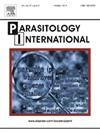Blastocystis colonization among inland and forest periphery Negritos in Malaysia: The crucial role of sanitation and hygiene practices
IF 1.5
4区 医学
Q3 PARASITOLOGY
引用次数: 0
Abstract
There has been an increasing trend in the study of Blastocystis due to its ubiquitous nature, and potential impact on human health. In Malaysia, its prevalence among the undeserved indigenous Orang Asli (OA) population varies widely from 1.7 %- 80.0 %. These huge differences were suggested to be attributed to disparities in living standards, including sanitation and access to treated water status. We investigated the prevalence, risk factors, and subtypes of Blastocystis among the OA Negritos residing in forest periphery villages and the inland jungle settings. A cross-sectional study was conducted involving 259 participants and their stool samples were screened microscopically for intestinal parasites and molecular techniques for Blastocystis. Risk factors including the type of village category and Blastocystis subtypes were identified. Of the 259 participants, 40 (15.4 %) were found to be colonized with Blastocystis. Prevalence was higher in the inland (17/81; 21.0 %) than in forest periphery villages (23/178; 12.9 %), but the difference was not statistically significant (P = 0.096). Among the 40 positive individuals, 31 (77.5 %) were co-infected with soil-transmitted helminths (STH). Multivariate analysis identified the unavailability of a household latrine (P < 0.001), infrequent washing hands after defecation (P = 0.005), having other household members positive with Blastocystis (P = 0.003), individuals from the Bateq subtribe (P = 0.011), and living in inland villages (P = 0.033) as significant predictors of Blastocystis colonization. Three subtypes were identified: ST1, ST2 and ST3 (the most predominant). We highlighted the critical role of hygiene and sanitation practices in the transmission dynamics of Blastocystis rather than type of village category or development status among OA. Continuous health practices, particularly on proper hygienic practices, should be emphasized especially concerning parasites transmitted via the fecal-oral route.

马来西亚内陆和森林外围黑人的囊虫定植:环境卫生和个人卫生习惯的关键作用
由于囊虫的普遍存在及其对人体健康的潜在影响,囊虫的研究有越来越多的趋势。在马来西亚,其患病率在土著原住民(OA)人口中差异很大,从1.7%到80.0%不等。这些巨大的差异被认为是由于生活水平的差异,包括卫生和获得处理过的水的状况。我们调查了居住在森林边缘村庄和内陆丛林环境中的OA黑人囊虫的患病率、危险因素和亚型。对259名参与者进行了横断面研究,并对其粪便样本进行了肠道寄生虫和囊虫分子技术筛选。危险因素包括村庄类型和囊虫亚型。在259名参与者中,40名(15.4%)被发现有囊虫定植。内陆地区患病率较高(17/81;21.1%)高于森林边缘村(23/178;12.9%),但差异无统计学意义(P = 0.096)。在40例阳性个体中,31例(77.5%)共感染土传蠕虫。多变量分析确定没有家庭厕所(P <;0.001)、便后不勤洗手(P = 0.005)、其他家庭成员携带囊虫阳性(P = 0.003)、来自Bateq亚部落的个体(P = 0.011)以及居住在内陆村庄(P = 0.033)是囊虫定殖的重要预测因素。鉴定出三种亚型:ST1、ST2和ST3(最主要)。我们强调了卫生和环境卫生习惯在囊虫传播动力学中的关键作用,而不是OA中村庄类别的类型或发展状况。应强调持续的保健做法,特别是关于适当的卫生做法,特别是关于通过粪-口途径传播的寄生虫。
本文章由计算机程序翻译,如有差异,请以英文原文为准。
求助全文
约1分钟内获得全文
求助全文
来源期刊

Parasitology International
医学-寄生虫学
CiteScore
4.00
自引率
10.50%
发文量
140
审稿时长
61 days
期刊介绍:
Parasitology International provides a medium for rapid, carefully reviewed publications in the field of human and animal parasitology. Original papers, rapid communications, and original case reports from all geographical areas and covering all parasitological disciplines, including structure, immunology, cell biology, biochemistry, molecular biology, and systematics, may be submitted. Reviews on recent developments are invited regularly, but suggestions in this respect are welcome. Letters to the Editor commenting on any aspect of the Journal are also welcome.
 求助内容:
求助内容: 应助结果提醒方式:
应助结果提醒方式:


